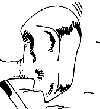








Coloring for Kids
All illustrations by Matthew Stewart.
Click on the portrait to view the whole picture, then print it out, and color!

Archaeopteryx
Archaeopteryx, literally meaning "ancient wing", could be the most famous fossil of all. It is thought to be the "missing link" between the reptiles and the birds, as it had all the features of a reptile, and yet possessed characteristics of birds such as a wishbone and feathers.

Carboniferous Scene
It was during the Carboniferous period that reptiles developed to be able to live on land. Also, the ancestors of birds, mammals, and reptiles evolved to be able to lay eggs on land.

Hallucigenia
Hallucigenia sparsa. This creature is from the Cambrian Period, and was found in the Burgess Shale.

Ichthyosaur
Ichthyosaurs lived in the sea but they still breathed air. Some fossils have been found with smaller Ichthyosaurs inside the larger ones, with no hint that they were eaten. This means that Ichthyosaurs gave birth to live young.

Imperial Mastadon
A different kind of elephant altogether from mammoths, Mastadons are typical of the last three million years of North America. Its average height is 3.5 m.

Nautiloid
Nautiloids were most abundant 400 million years ago, but today, only a single species of them survives in the south west Pacific Ocean. Nautiloids swam by squirting water out of their body cavity.

Stegosaurus
Stegosaurus, literally meaning "plated reptile", had a series of diamond-shaped plates on its back. The Stegosaurus was up to 9 m long, and its brain was the size of a walnut.

Tyrannosaurus Rex
Probably the best known of all dinosaurs, Tyrannosaurs were up to 15 m long and 6 m high. A person would hardly have reached its knee!
Paleontologists and MuseumsMuseums
Amateur Paleontologists